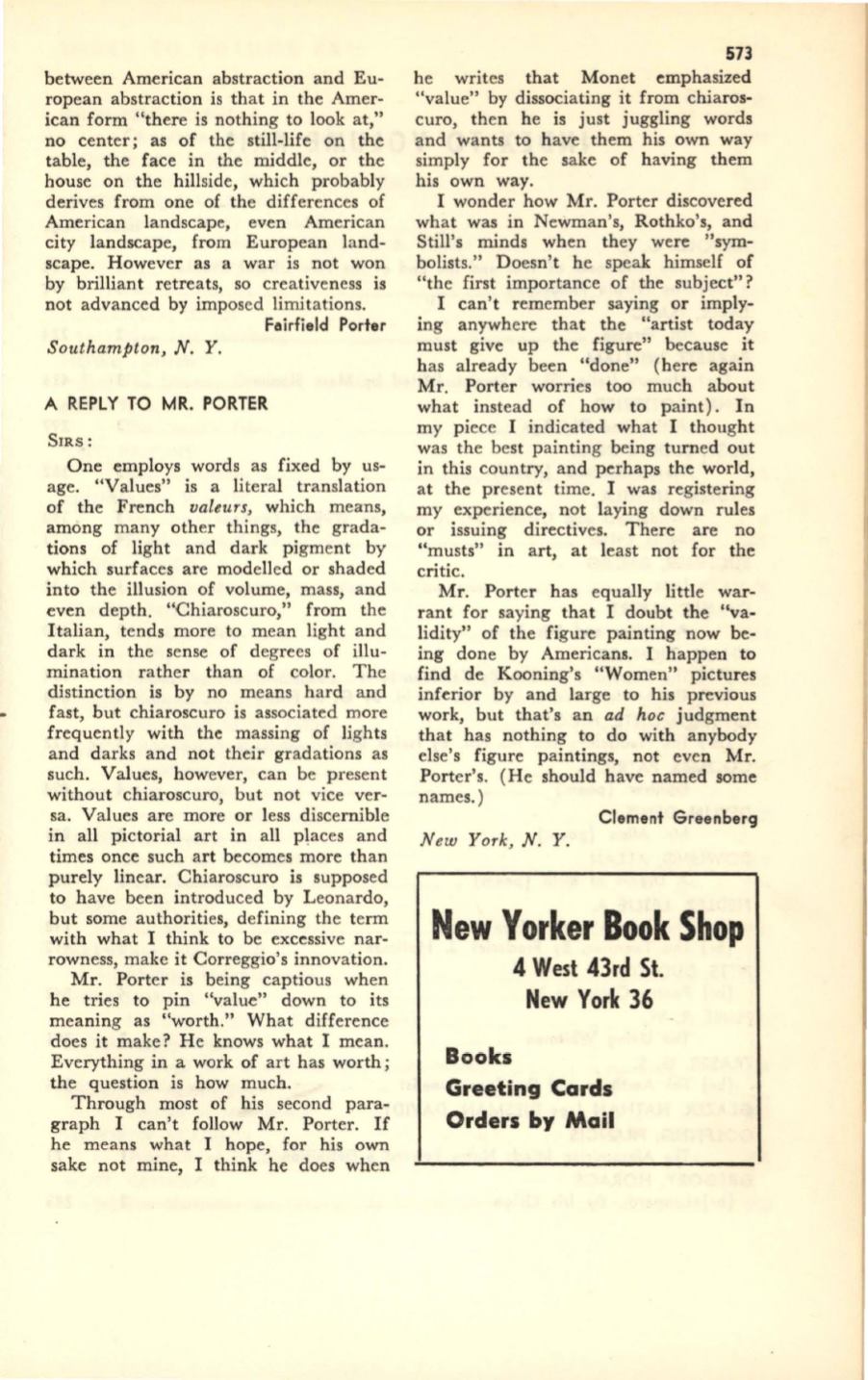
between American abstraction and Eu–
ropean abstraction is that in the Amer–
ican form "there is nothing to look at,"
no center; as of the still-life on the
table, the face in the middle, or the
house on the hillside, which probably
derives from one of the differences of
American landscape, even American
city landscape, from European land–
scape. However as a war is not won
by brilliant retreats, so creativeness is
not advanced by imposed limitations.
Fairfield Porter
Southampton, N. Y.
A REPLY TO MR. PORTER
SIRS:
One employs words as fixed by us–
age. "Values" is a literal translation
of the French
valeurs,
which means,
among many other things, the grada–
tions of light and dark pigment by
which surfaces are modelled or shaded
into the illusion of volume, mass, and
even depth. "Chiaroscuro," from the
Italian, tends more to mean light and
dark in the sense of degrees of illu–
mination rather than of color. The
distinction is by no means hard and
fast, but chiaroscuro is associated more
frequently with the massing of lights
and darks and not their gradations as
such. Values, however, can be present
without chiaroscuro, but not vice ver–
sa. Values are more or less discernible
in all pictorial art in all places and
times once such art becomes more than
purely linear. Chiaroscuro is supposed
to have been introduced by Leonardo,
but some authorities, defining the term
with what I think to be excessive nar–
rowness, make it Correggio's innovation.
Mr. Porter is being captious when
he tries to pin "value" down to its
meaning as "worth." What difference
does it make? He knows what I mean.
Everything
in
a work of art has worth;
the question is how much.
Through most of his second para–
graph I can't follow Mr. Porter.
If
he means what I hope, for his own
sake not mine, I think he does when
573
he writes that Monet emphasized
"value" by dissociating it from chiaros–
curo, then he is just juggling words
and wants to have them his own way
simply for the sake of having them
his own way.
I wonder how Mr. Porter discovered
what was in Newman's, Rothko's, and
Still's minds when they were "sym–
bolists." Doesn't he speak himself of
"the first importance of the subject"?
I can't remember saying or imply–
ing anywhere that the "artist today
must give up the figure" because it
has already been "done" (here again
Mr. Porter worries too much about
what instead of how to paint). In
my piece I indicated what I thought
was the best painting being turned out
in this country, and perhaps the world,
at the present time. I was registering
my experience, not laying down rules
or issuing directives. There are no
"musts" in art, at least not for the
critic.
Mr. Porter has equally little war–
rant for saying that I doubt the "va–
lidity" of the figure painting now be–
ing done by Americans. I happen to
find de Kooning's "Women" pictures
inferior by and large to his previous
work, but that's an
ad hoc
judgment
that has nothing to do with anybody
else's figure paintings, not even Mr.
Porter's. (He should have named some
names. )
Clement Greenberg
New York, N. Y.
New Yorker Book Shop
4 West 43rd St.
New York 36
Books
Greeting Cards
Orders
by
Mail


